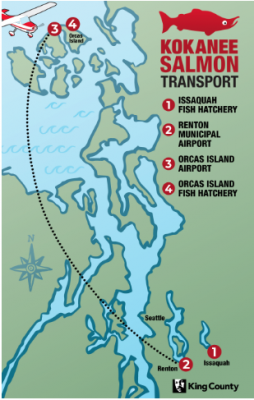A Busy Spring at the Hatchery
Spring has been very busy at the Issaquah Salmon Hatchery as the Department of Fish & Wildlife Staff (DFW) released Coho (April 1, 474,000) and Chinook (May 7 & May 14: 2.7M) smolt into Issaquah Creek.
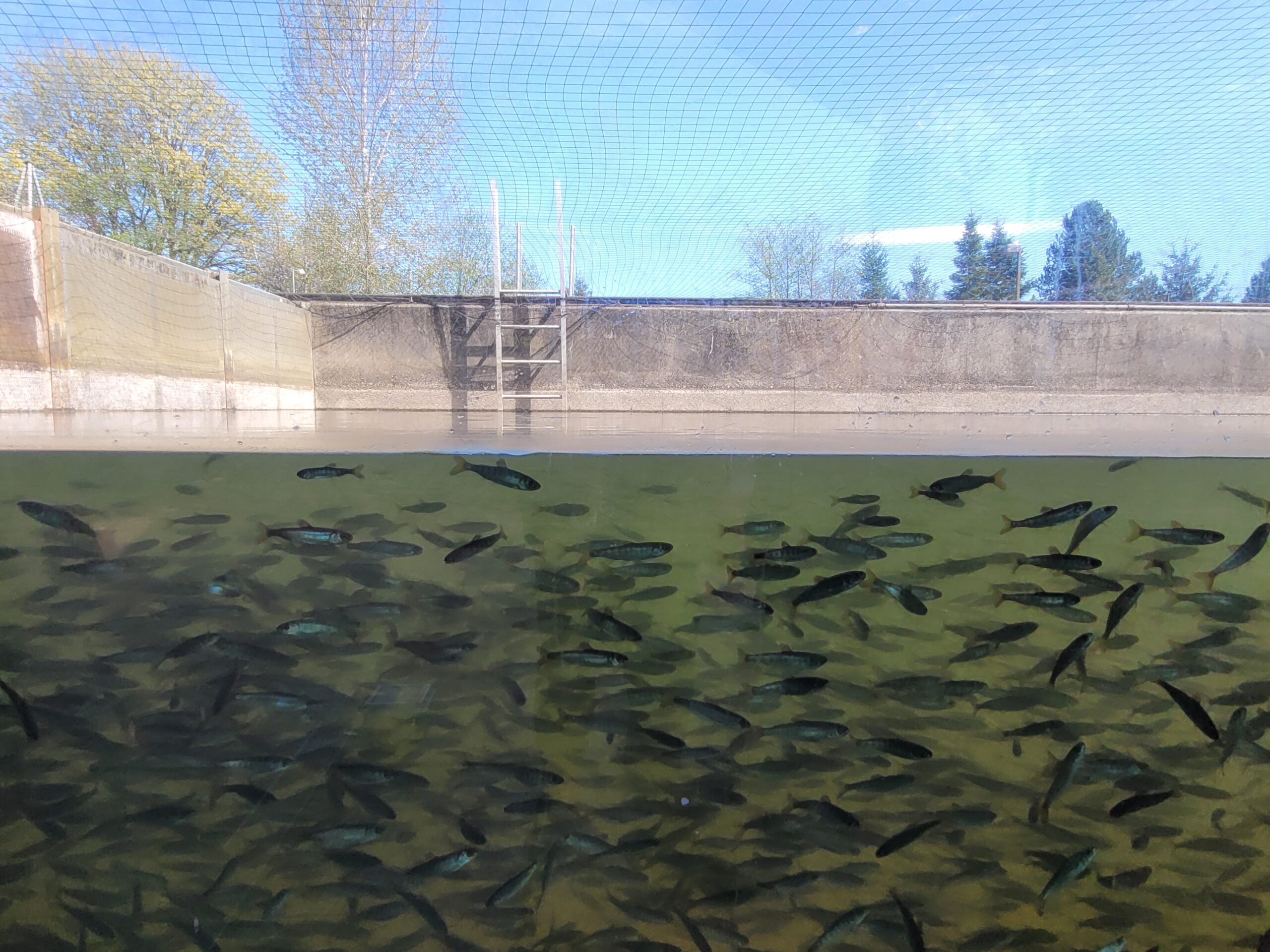
Activity involving the hatchery facility, including harvests, incubation updates, releases, facility improvements or changes, etc..
Spring has been very busy at the Issaquah Salmon Hatchery as the Department of Fish & Wildlife Staff (DFW) released Coho (April 1, 474,000) and Chinook (May 7 & May 14: 2.7M) smolt into Issaquah Creek.

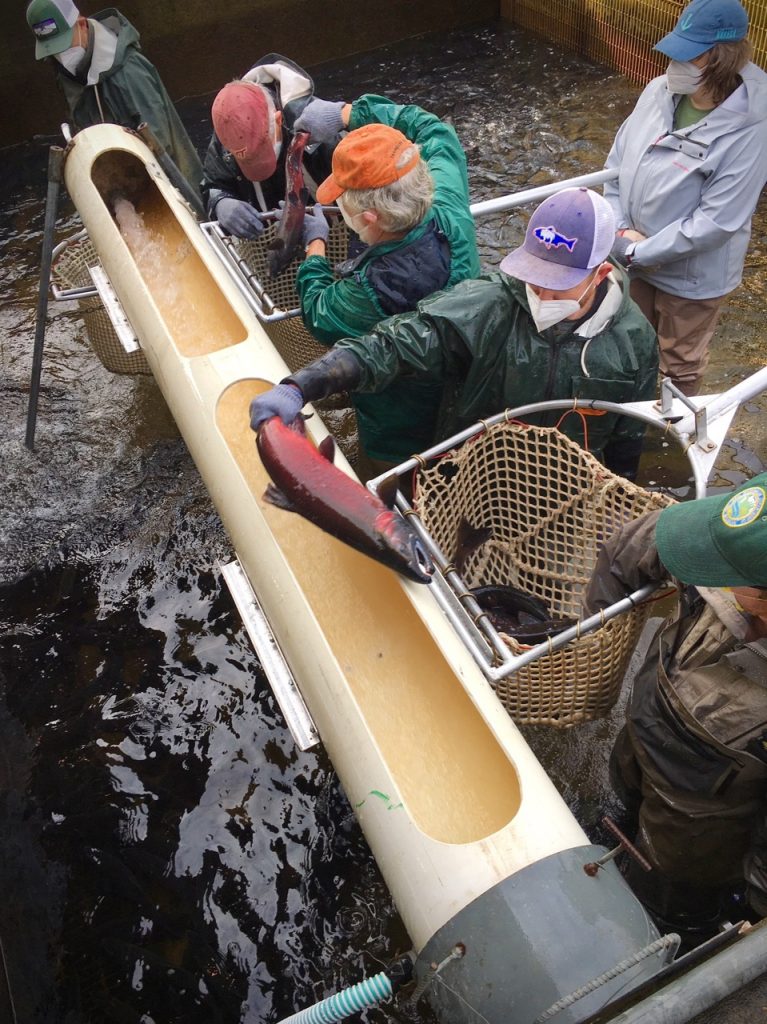
Issaquah hatchery staff and FISH volunteers harvested about 258,000 eggs during the first coho spawning of the 2020 season on Tuesday, Oct. 27. Eggs and milt were collected from 119 spawning pairs. The egg take represents about one quarter of the hatchery goal of 1 million eggs for the season. With a healthy return of fish so far this year, the hatchery was also able to release 419 coho upstream of the hatchery to continue farther up Issaquah Creek and spawn naturally. In addition, three late-arrival chinook were released upstream, and one rainbow trout that followed the salmon into the hatchery holding pond was returned to the wild as well. Coho spawning will continue for the next two to three weeks.
Stay tuned for more updates!
 Almost 2,500 kokanee fry bid a fond farewell to the Issaquah Salmon Hatchery on Oct. 26 as they started their new journey to Lake Sammamish. The lake’s threatened kokanee population, whose numbers have dwindled to just a few hundred in recent years, will get a boost from this new batch of fry which were incubated and raised at the Issaquah hatchery from eggs collected in late 2019.
Almost 2,500 kokanee fry bid a fond farewell to the Issaquah Salmon Hatchery on Oct. 26 as they started their new journey to Lake Sammamish. The lake’s threatened kokanee population, whose numbers have dwindled to just a few hundred in recent years, will get a boost from this new batch of fry which were incubated and raised at the Issaquah hatchery from eggs collected in late 2019.
The hatchery rearing program is part of the recovery efforts of the Kokanee Work Group, an alliance of federal, state, county and local agencies, tribes and non-profit organizations dedicated to ensuring the survival of Lake Sammamish’s “little red fish.” The effort has conducted annual fry release programs, including educational components for local students, for the last 10 years to raise awareness about the plight of these native fish, threatened by environmental challenges due to urbanization. This year, with the hatchery closed and students attending virtual classes, a public celebration was not possible.
In the past, fry were released at very early stages of development, when they were only about one inch long. In this second year, the hatchery retained and fed the fry for a longer period, until they reached 5-6 inches in length, continuing an experiment to determine if larger size, and cooler waters, help to prevent predation by other fish in the lake that may be depleting the population.
 Officials from the Washington Department of Fish and Wildlife and the King County Department of Natural Resources used buckets to transport the squirming kokanee fry from the hatchery incubation building into a waiting truck outfitted with a large covered tub of water. The eggs were collected from fish in Lewis Creek, at the south end of Lake Sammamish, so their progeny were transported back to Lewis Creek for release, and they were expected to migrate quickly to Lake Sammamish. There, they will grow and mature before returning to the stream to spawn at 3 or 4 years old. Bon voyage, little kokanee!
Officials from the Washington Department of Fish and Wildlife and the King County Department of Natural Resources used buckets to transport the squirming kokanee fry from the hatchery incubation building into a waiting truck outfitted with a large covered tub of water. The eggs were collected from fish in Lewis Creek, at the south end of Lake Sammamish, so their progeny were transported back to Lewis Creek for release, and they were expected to migrate quickly to Lake Sammamish. There, they will grow and mature before returning to the stream to spawn at 3 or 4 years old. Bon voyage, little kokanee!
The 2020 chinook spawning season is drawing to a close, and we’ve seen a lot of fish spawning in Issaquah Creek! The hatchery concluded the chinook spawning season on Oct. 13 with the fourth weekly egg take of the run. Hatchery staff and volunteers, all wearing masks, socially distanced, spawned a season total of 881 chinook hens and bucks, and collected 1.8 million eggs. Disappointingly, this number fell short of our goal of 3.2 million, so the Soos Creek Hatchery has provided 1.5 million extra chinook eggs to the Issaquah Hatchery for a total of 3.3 million eggs.
For the season, our hatchery saw roughly 2,348 chinook (35 natural origin) jump up the fish ladder and into the holding ponds. For the Greater Lake Washington Watershed, more than 12,000 chinook were counted entering the fresh water at the Ballard Locks. Some of those salmon headed to other streams to spawn, and many spawned downstream of the hatchery in Issaquah Creek.
Due to our warm, dry weather this fall, it was feared that a number of the chinook would not make it back to their spawning grounds. Those that did arrive were overwhelmingly male: about 75 percent, as the females are preferred by predators such as seals, sea lions and orcas.
Although the number of fish arriving at the hatchery this year was fewer than average, the hatchery released 51 chinook upstream above the weir to spawn in the upper reaches of Issaquah Creek. These were fish that were not ripe by the final spawning day at the hatchery.
The good news is that the weekend rains brought lots of coho upstream! At least 1,200 are currently trapped in the holding pond as of this writing. Coho spawning is expected to start in late October and continue through mid-November. Let’s route for big numbers this year!
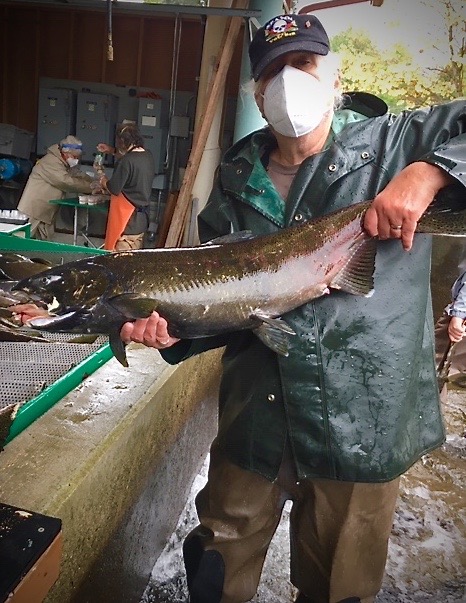
Oct. 9, 2020: Hatchery staff and volunteers have been spawning our chinook salmon since Sept. 22. After the third spawn, the hatchery has collected just 1.7 million eggs. This year’s goal is 3.3 million eggs, so this may be difficult to achieve.
While the chinook run is bigger than average this year, the vast majority of fish returning to the hatchery are males. The reason for the lopsided return is unknown, but we do know that predators generally prefer to feed on females with their tasty and nutritious eggs. WDFE staff will be picking up chinook eggs Tuesday, October 13 from the Soos Creek Hatchery to supplement our harvest and reach our goal for egg production — as they did last year as well.
Meanwhile, Issaquah Creek is full of spawning chinook below the hatchery, and coho are starting to return as well — although they won’t start spawning until later in October. We have also seen four sockeye in the creek so far.
The unseasonably warm and dry weather this fall has kept fish in Lake Sammamish for the last couple of weeks as they wait for rain to migrate upstream. The next storm should bring an influx of new fish to the hatchery.
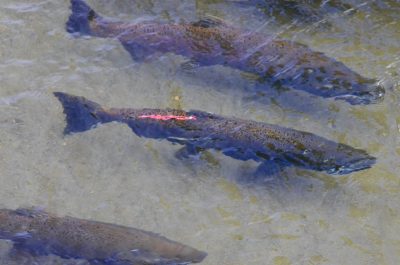
Updated from the original post on Friday, September 25, 2020: Some of the salmon in this year’s return are sporting a highly visible plastic string, telling any observer there is something important about this fish. In particular, this Chinook was captured at the Chittenden Locks by the Muckleshoot Indian Tribe, equipped with an internal tag (acoustic transmitter) that will ping multiple receivers in fixed positions as the fish makes it way from the Locks, through the Lake Washington Ship Canal, Lake Washington, the Sammamish River, Lake Sammamish, and finally, Issaquah Creek. The main purpose of tagging the hatchery fish is to document survival during their migration from the Locks to the hatchery. The last couple of years we have noticed a difference in numbers between the Lock counts and what shows up at the hatchery so we are trying to find out if and where we are losing fish.
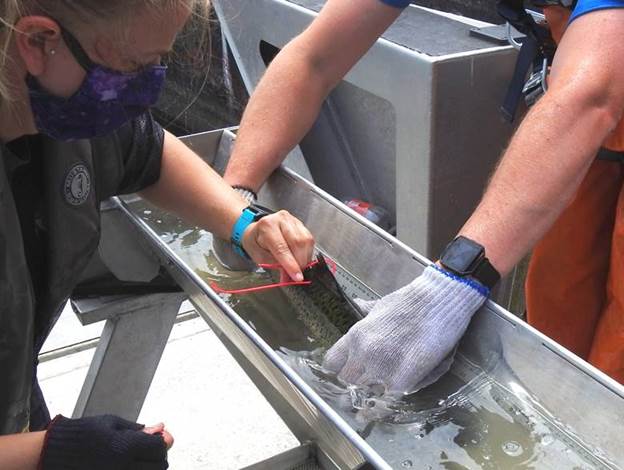
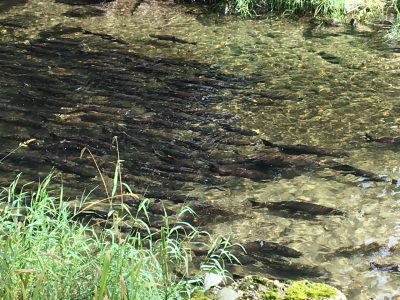 Wednesday, Sept. 23, 2020: The forecasted chinook return to the Issaquah Salmon Hatchery was about 4,000 fish. The number counted through the Chittenden Locks was 12,780 as of 09/20. What?!? Historically, 50 to 70% of the fish counted through the Locks make it to the Issaquah hatchery. Some of the chinook are headed to the Cedar River, where they are considered an endangered population, but most are headed our way.
Wednesday, Sept. 23, 2020: The forecasted chinook return to the Issaquah Salmon Hatchery was about 4,000 fish. The number counted through the Chittenden Locks was 12,780 as of 09/20. What?!? Historically, 50 to 70% of the fish counted through the Locks make it to the Issaquah hatchery. Some of the chinook are headed to the Cedar River, where they are considered an endangered population, but most are headed our way.
Another brush with reality: this time, the males outnumbered the females almost 3 to 1! We know that pinnipeds (and our beloved orcas) prefer female chinook – they are loaded with fat and protein-filled eggs, but this season that tendency is extreme.
The WDFW set a pretty high bar to assure the safety of the staff and volunteers at the spawning shed, but the shortfall of female chinook made it a short day, resulting in 328,000 fertilized eggs — a small but significant step to the 3,200,000 chinook egg goal for the year. The holding pond is full, the creek is full, so we are on a good path to meeting the goal.
What can we conclude from this?
Salmon return forecasting is even tougher than weather forecasting. And, we need to get good data on where the female attrition is happening, and whether something can be done about that.
~Larry Franks
Please note that the WDFW is not allowing tours on Tuesdays, spawning days, as keeping staff, volunteers and possible visitors safe is paramount.
The hatchery is and has been a crucial partner in the Kokanee restoration efforts. We can now celebrate the second safe transfer of Kokanee to Orcas Island to be reared. Read the latest great news!
Greetings, FISH friends! Today we present our spring fish release numbers — plus important information on a chinook study being launched by the Washington Department of Fish and Wildlife to try to better understand and combat fish predation on our outgoing salmon smolt. It’s a really important issue, and let’s hope this study brings the results we need. Read on…
Rainbow Trout:
Chinook salmon:
Coho salmon:
PIT TAG STUDY:
The Washington Department of Fish and Wildlife is running a study this spring, putting PIT tags into chinook smolt and releasing them over a range of time. The study will test the theory that if they are released early, when the lake water is cold, those warm-water fish that account for a great deal of the predation our smolt face have not fully woken up, and more of the smolts will make it across the lake. The PIT tags will be detected in several locations, including their passage through Chittenden Locks to Puget Sound, allowing the WDFW to better understand the predation issues with these young fish and to put into place better practices for the survival of our own salmon. A total of 5,000 tagged fish are planned to be released over the course of the spring releases. The study was made possible through a generous grant from the Candy & Don Havens Foundation
Working to better understand and protect salmon with fin clipping:
This year, the hatchery is hosting two marking trailers, one manual and one automated. The manual unit is processing approximately 35,000 salmon fingerlings per day, while the automated unit can process 140,000 per day!
About fin clipping… Clipping is a common practice conducted at most Washington salmon hatcheries to aid in fish identification. The adipose fin (between the dorsal and tail fins) is harmlessly removed. When the salmon return, they can be recognized as hatchery or wild origin, allowing us a better understanding of salmon populations over the years. It also helps us preserve wild salmon, as sport fishers are only allowed to take hatchery-origin fish.
Flood Recap:
In early February, following heavy rainfall, we experienced a record flow in Issaquah Creek of 2,400 cubic feet per second which resulted in:
Hatchery production remained safe but we came within 4 inches of floodwaters overtopping the raceways. Moreover, it was not good news for the naturally spawning coho, chinook, and, especially, native kokanee, who were most likely lost downstream.
Thanks to the heroic efforts of Washington Department of Fish and Game staff and FISH volunteers, however, the hatchery has recovered and our fish charges are safe. We are grateful to everyone who pitched in and are once again humbled by what nature can bring.
